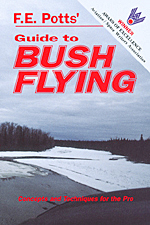A couple of years ago I was on Compuserve's AVSIG Forum when somebody started a thread about how dangerous it was to fly in Alaska because of the weather and terrain, and began proposing all kinds of absurd new regulations for the FAA to implement to "resolve" the Part 135 safety problem.
Mike Busch of AVWEB took my response to this foolishness and posted it as an article on his aviation web site. I am including it here in response to the many requests I have had for safety articles that relate to somewhat less specialized areas of aviation than Bush Flying.
In 1980, the National Transportation Safety Board conducted a special study of air taxi operations in Alaska. The Safety Board found that for the study period, the rate of non-fatal air taxi accidents in the state on the basis of hours flown was almost five times higher than the national rate, and the fatal accident rate was more than double the national rate. The Safety Board determined that the higher rates were due to inadequate airport facilities, insufficient ground navigational aids, and what it calls "the bush syndrome" - pilots taking unwarranted risks in order to complete a flight.
--Introductory NTSB comment by Mike Busch, AVWEB
I have an hour or two of flying in Alaska behind me, and in my humble opinion flying in Alaska is no more dangerous than down in the "lower 48." All it requires is a bit of judgment and common sense. But perhaps that is too much to ask of certain kinds of people.
It is a fact of nature that if you combine abnormally low intelligence with abnormally high levels of testosterone, you will have problems. Guns in the inner cities and airplanes in Alaska -- same phenomenon.
Making new laws will not solve this problem, for judgment can not be legislated. Yet these types of reports are usually the forbearer of new laws. The Part 135 operators in Alaska have a lousy reputation -- one richly deserved -- but then they have a strong tendency to hire kids at bottom dollar and force them (at penalty of losing their job) to fly in unsuitable conditions, with junky equipment, and way over-gross.
I was once fired from a Part 135 job in Alaska because I wouldn't take a grossly overloaded Beaver into a too-small lake. I was told to do it or they would get somebody who would. I wouldn't, and they did. The new pilot followed orders, and was dead from that very reason several months later. Took a number of passengers with him. It was called an "accident." Sure.
I was also once dismissed from another Part 135 job because I wouldn't fly a 206 with one inoperative magneto. The guy they got to take my place, a drunk from the next town, killed himself a few months later. Ran into a mountain in good VFR. Didn't have to embalm him -- he had enough booze in him to do the job nicely. That too was an "accident." Right.
I finally wised up, started my own business, and survived.
The higher accident rates aren't the fault of Alaska, for Alaska is a friendly place to fly. I much prefer flying up there than in the miserable, crowded, rule-infested Lower 48 with all its paved airports and FAA and regulations that are far more concerned with paper work and harassment than with encouraging the development of good judgment.
My, I'm in a grumpy mood. That always happens when some fool blames the Alaska terrain and weather for the accident rate, rather than placing it where it squarely belongs: on the fool in the left seat (and his boss).

